 SPIRITS PRIMER
SPIRITS PRIMER 
PDT is a small bar with a cocktail program that requires a wide variety of spirits. We feature a hand-picked selection of brands that are benchmarks of quality in their category, along with classic fortified wines, aperitifs, bitters, and liqueurs. There are many fabulous products we love but don’t have room to stock.
All the spirits used to prepare cocktails in this book are listed in their proper category, which is annotated to provide the reader with general information about each product’s provenance and production process. Some categories are localized, tightly regulated, and easy to summarize, while others are not, making them difficult to group together.
I’ve attempted to use U.S. and E.U. Standards of Identity sparingly and spend more time describing what a category is and less on what it isn’t or can’t be by law. This primer was written with PDT’s cocktail program and spirits selection in mind and is not a comprehensive overview of distilled spirits. The omission of a product or subcategory is not a reflection of my opinion of a particular brand.
The categorical descriptions presuppose a basic understanding of fermentation, distillation, and aging techniques, in addition to a familiarity with the terms used to describe and evaluate spirits and fortified wines. Thanks to the growing interest in fine spirits, there are a plethora of resources in the Bartender’s Library that provide this information, so the focus here is on the spirits we stock.
It’s important to note that many of the finest spirits we stock at the bar are not listed here or in the recipe section, due to their prohibitive cost. This by no means precludes preparing drinks with them: you should mix with the highest-quality ingredients you can afford.
VODKA
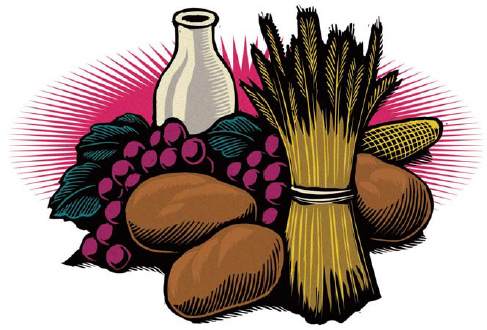
Vodka, which means “little water” in Russian and Polish, is distilled from a fermented mash of an astounding array of natural materials, including rye, wheat, potatoes, barley, grapes, tree sap, milk, and corn. The quality of the grain, the skill of the distiller, the purity of the water, and the particular filtration process used all determine the aroma, texture, body, and flavor of the final product. Most modern vodkas are column-distilled. Demineralized water is added to reduce the alcoholic strength to between 37.5 and 50 percent. The spirit is then filtered with activated charcoal, but diamond and sand are also used. Following fermentation, distillation, and filtration, the vodka is bottled. Western producers typically distill and filter as much flavor from the base material as possible, and Eastern European producers tend to preserve more of the grain base’s character, although this distinction is blurring. Many producers round the rectified spirit with a small quantity of sugar to add body and disguise coarse distillates.
Absolut 100 • Belvedere • Heart of the Hudson • Karlsson’s • Smirnoff Black
Flavored Vodka
Flavored Vodka isn’t a recent invention. Before the continuous still was patented, in the 19th century, Eastern European distillers spiced their potdistilled vodkas with herbs, seeds, and berries or sweetened them with honey to mask impurities and, in their view, endow medicinal value. Nowadays, the best flavored vodkas are produced by infusing fresh ingredients, macerating and redistilling them, adding them as a spirit-based tincture, or, in the worst cases, by adding artificial flavor through a cold-compounding process.
42 Below Kiwi • 42 Below Manuka Honey • Hanger One Buddha’s Hand
GIN
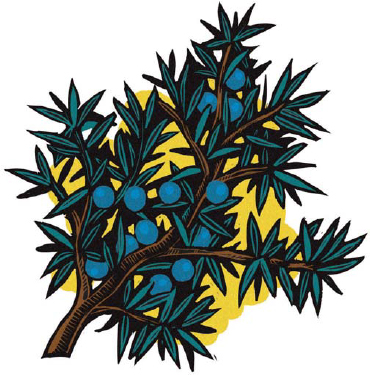
Gin, an anglicism of genever, the Dutch word for juniper, is made by flavoring a neutral grain spirit with juniper and other botanicals, such as orange peel and lemon peel, coriander, angelica, orris root, cardamom, grains of paradise, cubeb berries, almonds, and cassia bark. English gin evolved from Dutch genever into three prominent styles (in chronological order): Plymouth, Old Tom and London Dry. After years of declining sales beginning in the 1960s, the release of non-juniper-dominant gins, beginning with Bombay Sapphire in 1987, has renewed consumer interest in the category.
Genever
Genever, is produced in three styles: jonge, oude, and korenwijn. Genever distilled from grain only is labeled graanjenever. Jonge genever, introduced in the 1950s, contains more grain than malt and resembles modern vodka. Oude genever is produced by blending malt wine, an aromatic pot- and column-distilled concentrate from rye, wheat, barley, and sometimes corn with a highly rectified spirit and a botanical distillate prepared with juniper, angelica, coriander, licorice, and hops. Korenwijn (“cornwine”) is an 18thcentury style genever that is traditionally matured in used oak casks and contains between 51 and 70 percent malt wine and no more than 20 grams per liter of sugar.
Anchor Genevieve • Bols
Plymouth
During the 18th and 19th centuries, the British Royal Navy stocked Plymouth gin for their crews. Coates & Co. is the only company that still produces Plymouth gin, a protected appellation. Plymouth gin is distilled with seven botanicals in England’s oldest working distillery, according to the original 18th-century recipe, and rectified with water from the local Dartmoor reservoir.
Plymouth
Old Tom gin
is often described as the link between Dutch genever and London Dry gin; but it’s hard to imagine what the spirit tasted like, given the variety of recipes and techniques used to produce it during its heyday in the 19th century. Whether pot-distilled, as it was before the invention of the column still in the 1820s, or column-distilled, as it was when the technology became available, Old Tom gins were flavored with juniper and sweetened with sugar. A handful of modern producers offer renditions of the early style (Ransom) and the modern, more rectified style (Hayman’s).
Hayman’s • Ransom
London Dry Gin
Each house, which need not reside in London, employs a unique botanical recipe and distillation technique. Some distillers add the botanicals and spirit to the kettle, while others suspend the botanicals over the boiling pot, infusing the steam before it condenses. By law, no artificial flavoring is permitted and nothing can be added after distillation except spirit of the same standard, water and .5 gram of sugar per liter.
Beefeater • Beefeater 24 • Berkshire Mountain Distillery Greylock • Tanqueray
New Western Dry Gin
New Western Dry Gin, a description coined by Aviation Gin founder Ryan Magarian, is a category that emerged around the turn of the 21st century, following the success of subtly flavored gins such as Bombay Sapphire. New Western producers choose a neutral, not necessarily grain-based, spirit, and tend to work with a handful of botanicals that originate from the region where the gin is distilled. Juniper must remain dominant in all dry gins to achieve definition. Gins of this style allow other botanicals to share the spotlight.
Aviation • Hendrick’s
Aquavit
Aquavit production is similar to gin. Caraway, dill, fennel, citrus peel, anise, and other botanicals are macerated in high-proof neutral spirit, then distilled in a pot still. The resulting distillate is blended with a neutral grainor potato-based spirit and bottled or aged in-barrel. Aquavit produced in Denmark and Sweden is traditionally not aged, while Norwegian aquavit, produced from a potato-based spirit, is aged in former sherry casks.
Krogstad • Linie
SUGARCANE SPIRITS
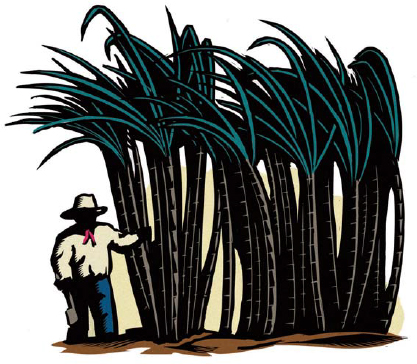
The history of rum follows sugarcane’s momentous journey from Asia to Africa and India to Spain. Seventeenth century French, English, Spanish, and Portuguese settlers in the New World brought unique distilling traditions to the colonies, where settlers cultivated sugarcane and made rum from fresh-pressed juice or molasses, a byproduct of sugar refining. The character of rum is based on many factors, including the type of sugarcane or molasses, the yeast, fermentation time, degree of rectification, type of still, time spent aging in wood, and use of additives. With few regulations governing the production of rum in place to help classify each style, I’ve grouped our sugarcane spirits into French Rhum and Cachaça produced from fresh-pressed cane, and rums produced from molasses and sugarcane syrup in the Spanish and English style. I’ve also included a passage about Indonesian Batavia Arrack.
Rhum (French)
In the French islands, rum is spelled with an h and classified as either Rhum Agricole, distilled from fermented fresh sugarcane juice, or Rhum Industriel, distilled from fermented molasses. Rhum Agricole is unique to the French departments of Martinique, Guadeloupe, and Reunion. It is typically distilled in a single-column still and rested in large tanks before bottling. Rhum Vieux Agricole is aged in new and used oak barrels for a minimum of 3 years. Each year, the barrels are topped off with rhum of the same vintage to replenish the up-to-10 percent of the liquid that evaporates due to the hot, humid tropical climate.
Barbancourt Blanc • Barbancourt 8 Year • J.M. Blanc • Neisson Blanc • Rhum Clément V.S.O.P.
Rum (Spanish)
Spaniard Don Facundo Bacardi revolutionized rum production in the middle of the 19th century on the island of Cuba through the use of column distillation, charcoal filtering, yeast cultivation, and select oak aging. Bacardi’s highly refined, delicate style of rum is generically referred to as the Spanish style. White rums produced in this style are column-distilled from molasses and frequently mellowed in oak before being filtered and bottled. Color is not a good measure of a rum’s age, as the color is often adjusted by adding caramel or, in the case of white rums, removed by carbon filtering. Due to the lack of laws governing rum production, age statements should be viewed with a dose of skepticism. Fortunately, rum matures quickly in the hot, humid climates of Central America and the Caribbean. Most aged rums are matured in former bourbon barrels, although Sherry, Cognac, and wine casks are also employed.
Bacardi 8 • Chairman’s Reserve • Flor de Caña Silver Dry • Havana Club 7-Year-Old • Matusalem Gran Reserva • Pampero Aniversario • Ron Zacapa 23 Centenario
Rum (English)
English distillers were slow to incorporate the Spanish technology due to prohibitive costs. Consequently, the English market retained a taste for the pungent, estery rums produced in traditional pot stills from slow-fermented molasses. Column stills were eventually installed in most distilleries by the 1930s, but many producers continue to blend pot-distilled rum to bolster the flavor profile, especially in Jamaica and Guyana. Regardless of the style, most rum distillers use imported molasses thanks to the consolidation of the sugar industry in the 19th century. Many rums of this style used to be aged in London dock warehouses, but nowadays most are aged where they’re produced in former bourbon barrels.
Appleton Estate Reserve • Appleton V/X • Banks 5 Island • Cruzan Black Strap • El Dorado 15-Year-Old • Gosling’s Black Seal • Lemon Hart Overproof • Mount Gay Eclipse Amber • Mt. Gay Eclipse White • Mount Gay X.O. • Myers’s Dark • Smith & Cross • Wray & Nephew Overproof
Cachaça
Cachaça is a Brazilian spirit distilled from fresh pressed sugarcane juice. By law, it must be bottled between 38 and 48 percent A.B.V., with no more than 6 grams of sugar per liter added to each bottle. Production is divided between artisanal cachaças, which are distilled in alembic pot stills, and industrial cachaças, which are column-distilled and account for the majority of the categories exports and sales. Aged cachaça is typically matured for a minimum of one year in wooden barrels. Many artisanal cachaças are not available because they are aged in native Brazilian woods that haven’t been approved for use in distilled-spirits production by the U.S. government.
Beleza Pura • Leblon • Mãe De Oro • Sagatiba
Batavia Arrack
Batavia Arrack is a sugarcane-based spirit produced from molasses that hails from the island of Java in Indonesia. The earthy quality of Arrack comes from the wild, uncultured yeast strains and the cakes of dried, cooked Javanese rice that are placed in the fermentation tubs to stimulate fermentation. Batavia is the old Dutch colonial name for Jakarta, Indonesia, which was the headquarters of the Dutch East India Trading Company during the 17th century. Arrack from Batavia was a popular base for grogs and punches in the late 18th and 19th centuries and is still used as the base for modern Swedish Punsch.
van Oosten
BRANDY
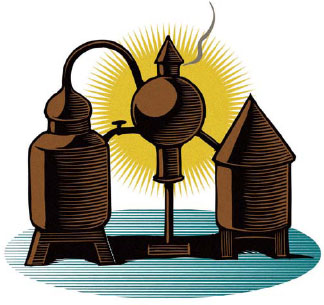
Brandy, from the Dutch term “brandewijn” (burned wine), refers to the process of distillation in which wine is heated in a pot still to produce vaporous alcohol. Brandy encompasses a number of categories including grappa, eau de vie, and marc, but generally refers to a distillate made from fermented fruit, sometimes aged in oak casks, that is traditionally bottled at 40 percent alcohol by volume.
Cognac
Cognac is named after a town in the Department of Charente, which lies north of Bordeaux and inland from the Atlantic coast of France. Here many of the finest brandies in the world are distilled from wines made with Ugni Blanc, Folle Blanche, and Colombard grapes, grown in chalky, loam and clay soils. Cognac is double-distilled in a unique pot still called the Charentais alembic. Cognac, by law, is matured in Limousin or Tronçais oak barrels for at least two years. Very Special (V.S.) Cognac is aged for at least two years; Very Superior Old Pale (V.S.O.P.) Cognac is aged for at least four years; and Extra Old (X.O.) Cognac is aged for at least six years. Virtually all Cognac is a blend of brandies of different ages from one or more of the six demarcated growing regions: Grande Champagne, Petite Champagne, Borderies, Fin Bois, Bon Bois, and Bois a Terroir.
Hine V.S.O.P. • Martell V.S.O.P. • Pierre Ferrand Ambre • Rémy Martin V.S.O.P
Peruvian Pisco
Peruvian Pisco is distilled from the musts of freshly fermented grapes harvested in a subtropical desert environment between the foothills of the Andes and the Pacific coast in Peru. Eight grape varieties are permitted including Quebranta, Molar, Italia, Moscatel, and Torontel. Peruvian pisco is pot-distilled after a long, natural fermentation, then rested for a minimum of three months in neutral vessels: nothing may be added to alter the flavor or appearance. Peruvian pisco is classified in four categories: puro, from one grape; aromatic or non-aromatic, depending on the grapes used; Mosto Verde, if the grapes are partially fermented; and Acholado, if a mix of aromatic and non-aromatic grapes is used. All Peruvian pisco is bottled at the proof it comes off the still. No reduction of alcohol level is permitted in any form.
Barsol Quebranta • La Diablada • Macchu Pisco
Applejack
Applejack, produced from bittersweet cider apples from trees planted by the Pilgrims, was one of the first spirits produced in America. Laird & Company, founded in 1780 in Scobeyville, New Jersey, is the oldest commercial distillery in the country. Laird's produces applejack, a blend of apple brandy and neutral spirit, and a range of apple brandies including a bonded (100-proof) apple brandy that requires 20 pounds of apples to produce each bottle.
Laird’s • Laird’s Bonded Apple Brandy
Eau de Vie
Eau de Vie, French for “Water of Life,” refers to the unaged alembic brandies produced from fresh fruit. The most famous come from the Alps region of Europe. Types include kirschwasser (cherries), framboise (raspberries), mirabelle (plums), and Poire Williams (pears) Clear Creek Kirschwasser • Clear Creek Pear Brandy • Clear Creek Plum Brandy • Nonino Gioiello • Trimbach Framboise
Brandy de Jerez
Brandy de Jerez is distilled from wine produced from Airen and Palomino grapes grown in La Mancha, in central Spain. Brandy de Jerez is distilled once using either a traditional copper pot or column still, then aged in 500-liter American oak casks that previously contained sherry. The final product is blended using a complex system known as “Solera,” in which brandies of different ages are blended and labeled as Solera, Solera Reserva, or Solera Gran Reserva grade brandy. Solera Gran Reserva brandy is entirely potdistilled and aged eight years on average.
Gran Duque D’Alba
AGAVE SPIRITS
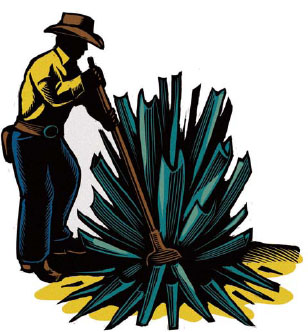
Historically, agave-based spirits were called vinos de mezcal. The primary distinction between mezcal and tequila is the species of agave used, the location of the agave fields, and the process in which the harvested agaves are roasted. Tequila producers steam or roast the piñas to convert their starches to sugar. Mezcal producers roast their piñas underground in stone pits, which gives the spirit an earthy, smoky quality.
Tequila
Tequila is produced from only one species of agave, the Agave Azul Tequilana Weber, a member of the lily (amaryllis) family. The hearts of the agave plants, called piñas, look like gigantic pineapples and take between 6 and 12 years to fully mature. The piñas are hand-harvested when ripe, trimmed, and steamed or roasted in stone ovens to convert their starch to sugar. The cooked agaves are milled, fermented, and either pot- or column-distilled at least twice. Mexican law states that tequila can be produced anywhere in the state of Jalisco or parts of Nayarit, Michoacán, Guanajuato, and Tamaulipas.
Blanco Tequila
Blanco Tequila is stored for up to 60 days after distillation, then bottled.
El Tesoro Platinum • Gran Centenario • José Cuervo Platino • L & J • Partida • Siembra Azul • Siete Leguas
Reposado Tequila
Reposado Tequila is “rested” between 2 and 12 months in wood containers of varying origin and size. The former contents of the oak casks, typically American whiskey, can influence the flavor of the tequila. For this reason, many producers are conducting aging experiments with new American and French oak.
Don Julio • El Tesoro • Gran Cententario • José Cuervo Tradicional • Partida • Siembra Azul • Siete Leguas
Añejo Tequila
Añejo Tequila must be aged for a minimum of a year, but not more than 3 years in oak barrels no larger than 600 liters.
Don Julio • El Tesoro • Ocho
Mezcal
Mezcal is an agave-based spirit produced in the Mexican state of Oaxaca. Its International Denomination of Origin designates a total of 5 states and 2 towns that can grow agave in Oaxaca and produce mezcal. Mezcal can be made from up to 30 different agave varieties, the most common being Espadín. The hearts of the hand-harvested agaves are placed in wood-fireheated, subterranean, rock-lined pits and covered with earth. The 3- to 5-day roasting process imbues the agave with earthy, smoky qualities and converts the plant’s starch to sugar. The roasted agaves are milled and fermented in wooden tubs. The mash is distilled in small, 25-gallon copper or ceramic pot stills and bottled within 2 months as blanco; between 2 and 12 months in oak as reposado; or aged at least 12 months in 200-liter oak casks as añejo. Pechuga mezcal is distilled a third time with the addition of wild fruits, nuts, and a chicken breast suspended below the condenser of a clay still. It is the newest and fourth category included in the Mexican appellation guidelines.
Del Maguey Vida • Illegal Reposado • Sombra
WHISK(E)Y
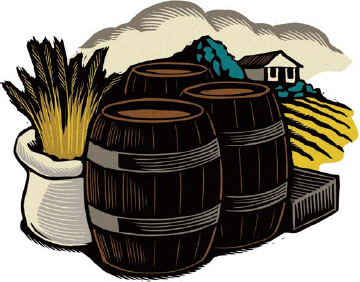
Sometime before the 15th century, somewhere in Ireland, uisce beatha (Gaelic for “water of life”)—or whiskey, as we know it now—was created. Whiskey, spelled with an e in the U.S. and Ireland and without it in Scotland, Japan, and Canada, is distilled from a fermented mash of grain (beer), usually corn, rye, barley, or wheat, and then aged in oak barrels. The mash bill, the type of wood and char employed to season the barrel, the climate at the facility the whiskey is aged in, and the amount of time spent in wood all affect the final product.
Whiskey
Straight Whiskey must, by U.S. law, be comprised of a minimum of 51 percent of one grain, must be aged in new, charred wood barrels for at least 2 years, and cannot be distilled at higher than 160 proof. (The exception is corn whiskey, which does not have to be aged in new charred barrels and has no minimum maturation requirements.) If the whiskey has been aged for less than 4 years in-barrel, no age may be stated on the label.
Bernheim Wheat Whiskey • Glen Thunder Corn Whiskey • Old Potrero Hotalings
Bourbon
Straight Bourbon can legally be produced in any U.S. state, though most hail from Kentucky. Straight Bourbon is made from a mash bill that is between 51 and 79 percent corn; distilled below 160 proof; aged in new, charred oak barrels at no more than 125 proof for a minimum of two years; and may not be diluted below 80 proof. Any bourbon less than 4 years old must state the whiskey’s age. Any age statement refers to the youngest whiskey in the bottle. Bourbon is named after a county in Kentucky where today, ironically, it’s a dry county and none of the major brands are produced.
Booker’s • Bulleit • Elijah Craig 12-Year-Old • Four Roses • Four Roses Single Barrel • George T. Stagg • Maker’s Mark • Old Grand-Dad Bonded • Woodford Reserve
Tennessee Sour Mash
Tennessee Sour Mash Whiskey is made the same way as bourbon, with two key differences: first, it must come from Tennessee; and, second, after distillation and before maturation in new oak barrels, it must be filtered through charred sugar maple charcoal (known as the Lincoln County Process). It takes from 10 to 12 days for the spirit to drip through the vats of charcoal, which strip away impurities in the distillate and give the whiskey a sooty quality.
George Dickel No. 12
Rye
Straight Rye can be made in any U.S. state, but must be prepared from a mash bill that contains at least 51 percent rye. Distillation, proof, cooperage, and aging requirements are the same as straight bourbon. Straight rye or bourbon whiskey bottled-in-bond, such as Rittenhouse, must be aged for a minimum of 4 years, be a product of one distillery, be distilled during a single season, and be bottled at 100 proof.
Old Overholt • Rittenhouse Bonded • Sazerac 6-Year-Old • Wild Turkey • Wild Turkey Russell’s Reserve 6-Year-Old
Irish Whiskey
Irish Whiskey is typically triple-distilled in either pot or column stills from a mash of corn, malted, or un-malted barley. It must be aged for a minimum of 3 years in wood barrels (typically former bourbon or Sherry casks, although former Port and Madeira casks are also used). Today, most Irish whiskey is a combination of pot- and column-distilled malt and grain whiskies that are blended before aging. Single malts, both peated and unpeated, are made from 100% malted barley. Pure pot-still whiskey is produced from a blend of malted and unmalted barley. The overwhelming majority of Irish whiskey is a blend of grain and malt whiskeys.
Black Bush • Bushmills • Jameson • Jameson 12-Year-Old
Scotch Whisky
Scotch Whisky must be produced in Scotland from water, grain, and yeast; spend no less than 3 years in oak casks no larger than 700 liters; and be bottled no lower than 80 proof. Some scotches get their characteristic smoky flavor from the malting process, in which peat smoke is used to dry malted barley, the only grain used to produce Scotland’s famed single-malt whiskies.
Blended Scotch Whisky
Blended Scotch Whisky, by far the most popular category of whisky in the world, is 60 to 70 percent grain spirit, (column-distilled corn or wheat whiskey) and 30 to 40 percent single-malt whisky. Any age statement on the bottle refers to the age of the youngest whisky in the blend.
Chivas Regal 12-Year-Old • Compass Box Asyla • Famous Grouse
Blended Malt Scotch Whisky
Blended Malt Scotch Whisky, formerly known as vatted malts, are made by blending single-malt whiskies from at least two different distilleries. The master blender marries the malts to achieve a characteristic style.
Compass Box Oak Cross • Compass Box Peat Monster
Single Malt Scotch Whisky
Single Malt Scotch Whisky must be produced in a single distillery from 100 percent malted barley that is double pot distilled to around 60 to 70 percent alcohol and bottled between 40 and 46 percent alcohol by volume. The age statement on the bottle refers to the age of the youngest malt whisky. Most single malts are matured in old bourbon barrels or sherry butts, though a wide array of used barrel types are being employed, such as port pipes, Madeira barrels, and wine barrels.
Ardbeg 10-Year-Old • Benromach 12-Year-Old • Glenlivet 12-Year-Old • Laphroig 10-Year-Old • Oban 14-Year-Old • Talisker 10-Year-Old
Japanese Malt Whisky
Japanese Malt Whisky is inspired by the production methods and styles of Scotch whisky, which Nikka founder Masataka Taketsuru studied in Scotland and brought to Japan in 1920. Today, there are eight operational malt whisky distilleries in Japan, two owned by Suntory and two by Nikka, by far the largest producers. Most of the malt and grain is imported, and Scottish production methods are followed. Bourbon and sherry casks of varying sizes are used for aging, along with a selection of Japanese oak barrels. Unlike the whisky business in Scotland, Japanese companies don’t trade malt and grain whiskies with each other, limiting the diversity of each producer’s blends.
Nikka Taketsuru 12-Year-Old • Yamazaki 12-Year-Old
AROMATIZED WINES & BITTERS
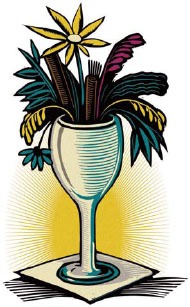
The addition of herbs and spices to wine can be traced back to the medicinal practices of the ancient Greeks. Spirit functions as a preservative when added to wine, slowing oxidation, preserving aromatic infusions, and retarding acidification. Knowledge of distillation, transferred from Islamic alchemists to Christian physicians around the 12th century, had spread throughout Europe by the 13th century. The clergy were the first to experiment with the process of transforming wine into spirit, which was spiced for health purposes and sweetened to make it more palatable. Eventually, the technology was acquired by apothecaries and druggists, whose commercial prescriptions loosely resemble the bitters listed below.
Vermouth
The word vermouth is derived from wermut, High German for “wormwood.” It’s produced by fortifying and sweetening a white wine base, frequently 75 percent of the mixture, with botanicals to balance the sweetness and endow medicinal value. Italian producers prefer light, fresh wine to make vermouth, and the French age their base wine, allowing for oxidation. Vermouth must be made with wormwood leaves, supported by upwards of 50 other herbs and spices, including cinnamon, nutmeg, clove, coriander seed, juniper, and cardamom. The botanical essences are extracted by steeping them in wine, distilling or macerating in hot water or alcohol. Dry vermouth is typically sweetened with up to 40 grams of sugar per liter; sweet and bianco vermouth can have up to 150 grams of sugar per liter. Vermouth production is centered in the countrysides of Italy and France, where crisp white wine, herbs, and spices are abundant.
Carpano Antica • Dolin Blanc • Dolin Dry • Dolin Sweet • Martini Bianco • Martini Sweet • Noilly Prat Dry • Punt e Mes • Vya Dry • Vya Sweet
Quinquinas and Wine-Based Aperitifs
Ever since its discovery in the 17th century, quinine, a virtually unpalatable extract of Peruvian cinchona tree bark, has been valued for its ability to combat malaria and ward off fever. In response to growing casualties from malaria in the Algerian War during the 1840s, the French government committed funds to award a wine-based recipe to facilitate its consumption. French entrepreneurs such as Joseph Dubonnet responded with fortified wines, aromatized with quinine, herbs, and spices, which eventually became known as quinquinas. Along with other popular wine-based aperitifs such as Lillet, quinquinas are prepared from a red- or white-wine base that is fortified with neutral spirit, sweetened with sugar or mistelle, and aromatized with bitter herbs and spices such as cinchona bark, coffee beans, orange peel, and cinnamon. Most wine-based aperitifs are barrel-aged, then bottled between 14 and 17 percent alcohol by volume.
Cocchi Americano • Dubonnet Rouge • Lillet Blanc • Lillet Rouge
Bitters
Bitters are concentrated spirit-based infusions or distillations of herbs, roots, barks, and spices that were originally produced and prescribed by medieval monks and apothecaries as elixirs and health tonics in northern Europe, Italy, France, and Spain. Commercial bitters were popularized in the Netherlands by firms such as Lucas Bols in the 16th century, but nowadays the widest variety comes from Italy, where they are known as amari. Bitterness from gentian, quinine, wormwood, artichoke leaves, dandelion, bitter orange, and angelica is balanced with aromatic botanicals such as vanilla, clove, nutmeg, and peppermint. Amari can be divided into two camps: the strong, intensely bitter after-dinner variety typified by Fernet Branca, and the low-proof, pre-prandial, bittersweet family headed by Campari. Each brand has its own secret, proprietary recipe and production process that is handed down through the ages.
Amer Picon • Aperol • Averna • Campari • Ciociaro • Cynar • Fernet Branca • Gran Classico • Luxardo • Nonino • Suze • Zwack
ABSINTHE
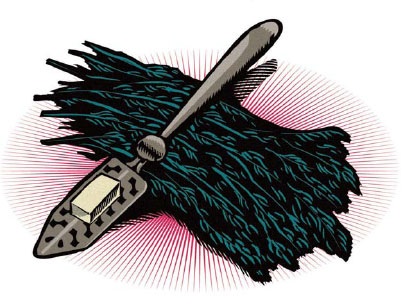
Absinthe is named after the Latin word for its primary botanical, Artemisia absinthium. Absinthe production is similar to gin. A pot still is filled with high-proof neutral spirit, typically grape-based, and dried botanicals, including wormwood, green anise, and fennel seed. The three primary botanicals may be supplemented with a host of other herbs and spices, including coriander, angelica, balm, and mint, depending on the distiller’s preference. Water is added and the mixture is distilled, producing a clear, aromatic spirit that’s bottled clear as absinthe blanche, or it undergoes a secondary maceration with dried botanicals to color it green, producing the more common absinthe verte. Traditional absinthe is bottled between 60 and 75 percent alcohol and must be diluted to enjoy responsibly.
Edouard • Kübler • Pernod • St. George • Vieux Pontarlier
Pastis
Pastis, literally “hazy” in a Southern French dialect, refers to the cloudiness that occurs when water is added to the spirit. Essential oils from the botanicals, including the aniseed and resinous parts of the licorice plant that are captured during maceration and distillation, precipitate when the pastis is combined with water and the liquid becomes opalescent. After absinthe was banned in France in 1915, various firms marketed this star anise, fennel and licorice-driven spirit in its place.
Pernod • Ricard
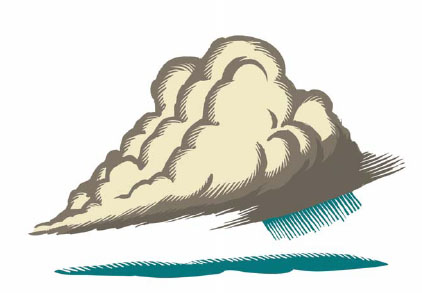
LIQUEURS
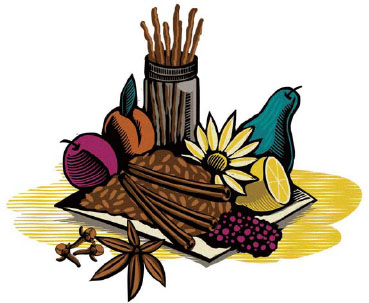
Liqueurs, from the Latin liquefacere, meaning to melt or dissolve, are produced by flavoring a base spirit by distillation, maceration, or percolation—or, for lesser-quality liqueurs, by compounding extracts with neutral spirit. Liqueurs are sweetened to between 20 and 35 percent of their weight by volume, crèmes by up to 40 percent.
Herbal
During the 13th and 14th centuries, physicians and monks believed that the medicinal properties of herbs, spices, and bark could be preserved in alcohol and used to treat and prevent illnesses. Herbal liqueurs, flavored through a combination of maceration and distillation of dozens of botanicals, were sweetened with honey and, later, sugar. The flavor and aroma of these complex liqueurs is derived through the use of multiple ingredients; no single note dominates.
Bärenjäger • Bénédictine • Carlshamns Flaggpunsch • Chartreuse Green • Chartreuse Green V.E.P.• Chartreuse Yellow • Drambuie • Galliano L’Autentico • Licor 43 • Strega
Floral
Floral Liqueurs entered the social realm in the 16th century when Italy’s Catherine de Medici married France’s Henry II and brought her taste for liqueurs to the royal court. The popularity and variety of liqueurs grew as apothecaries created new potions with flowers, herbs, and plants. Louis XIV’s favorite, rossolis, was prepared from a blend of orange flowers, musk roses, lilies, jasmine, cinnamon, and cloves. Fanciful floral liqueurs such as the violet-tinged Parfait Amour and Crème Yvette remained popular tipples throughout the Victorian Era.
Crème Yvette • Rothman & Winter Crème de Violette • St. Germain
Peel and Fruit
The Chinese cultivated oranges hundreds of years before they reached Europe during the Arab conquest of Spain in the 8th century. Sweet oranges didn’t arrive until the 15th century, and oranges remained a rare delicacy until the 19th century. The Dutch were the first to incorporate oranges in liqueurs and bitters, produced with the dried peel in the 16th and 17th centuries. Fruit liqueurs, such as Cherry Heering, didn’t become popular until the 19th century, and were typically prepared by macerating or adding juice to neutral spirit, compounding fruit extracts, or through distillation, as is the case with maraschino and many of the citrus liqueurs.
Belle de Brillet • Cherry Heering • Cointreau • Grand Marnier • Luxardo Maraschino • Mandarin Napoleon • Maraska Maraschino • Marie Brizard Crème de Banane • Marie Brizard Orange Curaçao • Mathilde Pear • Mathilde Pêche • Pama Pomegranate • Pimms #1 Cup • Plymouth Sloe Gin • Rothman & Winter Orchard Apricot • Rothman & Winter Orchard Pear • Schönauer Apfel Schnapps • Theuriet Cassis
Nut, Bean and Seed
Many of the ingredients in this category—anise, almond, and vanilla—play supporting roles in other liqueurs, but here they are the focal ingredient. Among many new flavors, anisette, amaretto, crèmes de cacao, and menthe became popular in the 18th and 19th centuries as improved transportation and new trade routes flooded Europe with exotic fruits and spices. The full complement of production methods are used to prepare these seemingly simple liqueurs that are typically blended with other ingredients to showcase the right notes.
Borsci Sambuca • Canton Ginger • Godiva Original • John D. Taylor’s Velvet Falernum • Kahlúa • Luxardo Amaretto • Marie Brizard Dark Crème de Cacao • Marie Brizard White Crème de Cacao • Monteverdi Nocino • Navan Vanilla Liqueur • St. Elizabeth Allspice Dram
FORTIFIED WINES
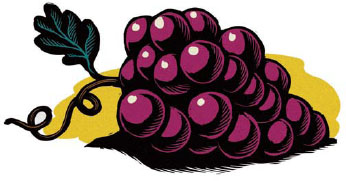
Fortified Wines have high-proof grape spirit added to increase their alcohol content beyond the percentage possible by natural fermentation, usually 16 to 20 percent alcohol. The three most famous styles, Sherry, Port, and Madeira, were fortified to withstand the arduous sea voyage to Britain, their largest market.
Sherry
Sherry, or Jerez, as the Spaniards call it, comes from the southern Spanish province of Andalucia. The coastal Atlantic breeze and the chalky, calcareous soil of Jerez preserve the bright, fresh fruit and focused acidity of the wines produced from the Palomino grape. Sherries fall into a wide array of styles from the lean, minerally manzanillas, finos and amontillados to rich olorosos, on to the sweet wines made with either Pedro Ximénez or Moscatel grapes that are dried in the sun before fermentation. In order to maintain consistent house styles and to provide the local yeast (flor) with the nutrients it needs to prevent oxidation in the dry wines, sherries are aged in a Solera system, where young wines are blended with old wines.
Lustau Cream • Lustau East India • Lsutau Manzanilla • Lustau Palo Cortado • Lustau Pedro Ximénez
Madeira
Madeira, an island between Portugal and North Africa, is where ships traveling along the spice route from Europe to East India loaded up on wines for their voyage. The sailors prized Madeira wines because they improved in casks stored in the holds of ships that sailed the rocky seas around the hot coast of Africa. Today, Madeiras are stored in heated rooms that mimic the effects of a long sea voyage south of the equator. Madeira comes in four different styles, named after the grapes they are made with. The flavor profiles range from light, dry Sercials and Verdehlos to the rich, honeyed Buals and Malmseys.
Blandy’s Sercial
Port
Port hails from the Douro region of Portugal, and unlike the other two fortified wines, it’s made with red grapes. Port replaced claret, or Bordeaux, as the Brits’ tipple of choice in the 1600s during one of many periods of hostility between the French and the British, and has remained a favorite of the international market. It’s made by adding grape neutral spirit before the wine ferments all the way, leaving behind natural residual sugar. Styles range from fruit-forward, young Ruby to more sophisticated, aged Tawnies, to Vintage and Late Bottled Vintage ports that require aging to subdue the fruit and smooth the coarse tannins.
Dow’s Ruby • Dow’s Tawny • Noval Black